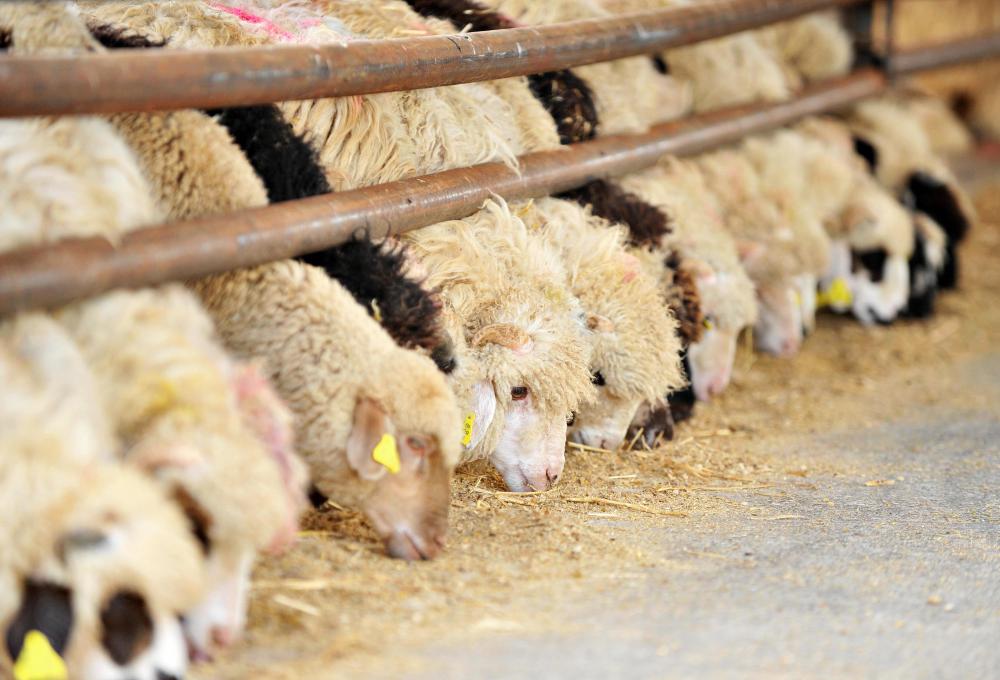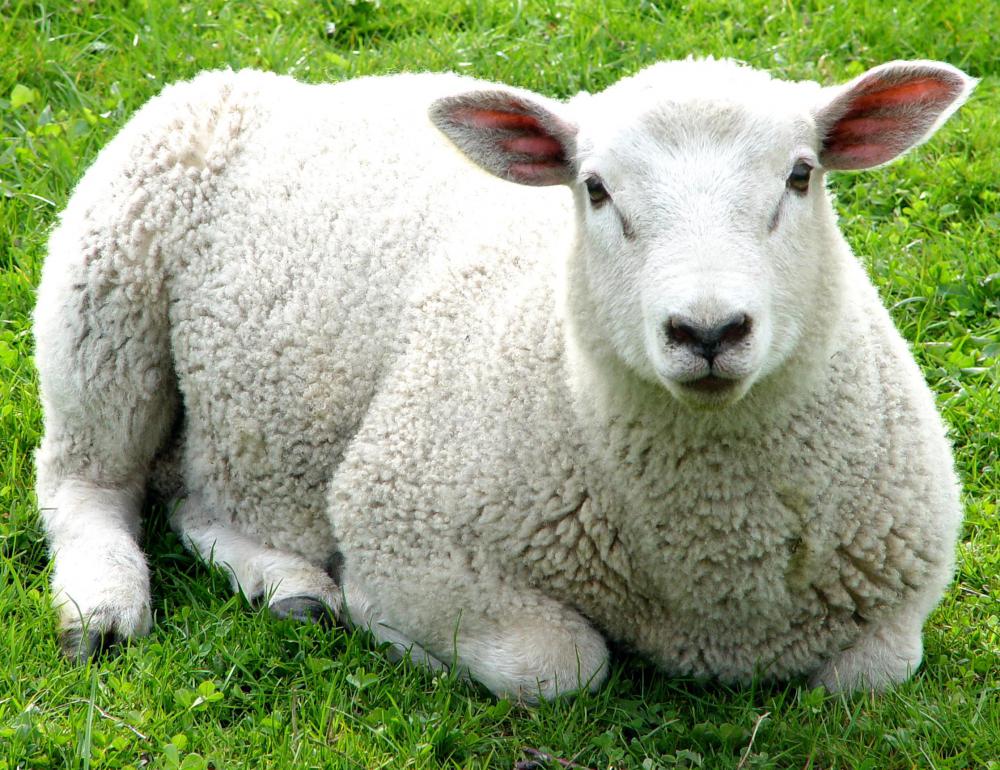At AllThingsNature, we're committed to delivering accurate, trustworthy information. Our expert-authored content is rigorously fact-checked and sourced from credible authorities. Discover how we uphold the highest standards in providing you with reliable knowledge.
How do I Breed Sheep?
Breeding sheep can be a rewarding and lucrative venture. Many people around the world breed sheep for a variety of different reasons, including wool, milk, and meat. One of the most important things to consider before you begin this type of livestock farming is the health of your sheep. Healthy males and females can be allowed to mingle, and nature will usually take over from there.
Sheep farming experts recommend that any sheep that are ill or have any other types of physical problems should not be bred. Before they are bred, both male sheep, known as rams, and female sheep, known as ewes, should be looked over by a veterinarian. If you choose to breed sheep with hoof, teeth, leg, or udder problems, these negative defects could be passed on to their offspring.

Ewes should be at least a year or two old weigh at least 70% of their expected mature weight. Females that are too young, too old, or underweight have an increased chance of having miscarriages or giving birth to deformed lambs. It is also important for them to be able to produce milk to nurse their babies, so most sheep farmers advise against trying to breed sheep with udder problems.

Rams can also be checked by a veterinarian to ensure that they have viable sperm. During breeding, many farmers who breed sheep also notice that they will usually need to eat more, since they have a tendency to tire quickly. Rams can either be purchased or rented. If you plan to breed sheep often, purchasing one or more may be more economical and easier in the long run.

Ewes that are ready to mate are referred to as being "in heat." Depending on the types of sheep you will be breeding, this usually happens around every 17 to 21 days and generally lasts for about a day. When she is in heat, a ewe will typically pay more attention to a ram, wagging her tail at him, nuzzling his underside, or sometimes even mounting him. At this point, the males can be mixed with the females, and nature will take its course.

The first month that a ewe is pregnant is the most critical. She should be kept calm and comfortable, since stress could cause her to miscarry. For example, you should never vaccinate or shear sheep that are in their first months of pregnancy. During the fifth month of pregnancy, most pregnant ewes will need extra grain, since this is the month that the lamb will grow the most.

At the end of the fifth month, usually the ewe will give birth. Signs that labor is about to start will begin a couple of days before, and can include discharge from the vagina as well as swelling. Ewes may also keep their distance from the other sheep, and some may paw at the ground.
The first part of the labor, the dilation of the ewe's cervix, will typically not last longer than four hours. After the water breaks, the lamb will often be born, front feet and head first, within an hour, and the placenta should pass within three hours after that. Ewes that do not give birth within two hours of their water breaking may need assistance.
After a lamb is out, the mother should start cleaning it's face and bonding with it. If she does not do this, she may be ill or possibly ready to give birth to another lamb. With the exception of keeping them comfortable, the ewe and her new baby should not be bothered. Also, rams should be kept away from the newborns, since there is a chance that they could hurt them.
Frequently Asked Questions
What is the best age to start breeding sheep?
Sheep reach sexual maturity at different ages depending on the breed, but generally, ewes can be bred at around 7 to 8 months old, while rams are often ready by 6 months. However, it's advisable to wait until ewes are at least 75% of their mature body weight to ensure healthy offspring and to prevent health issues in the mother, according to sheep breeding guidelines.
How do I select sheep for breeding?
Selecting sheep for breeding should focus on health, genetics, and breed characteristics. Look for animals free from defects and diseases, with a good body condition and desirable traits such as wool quality or meat yield. Genetic diversity is also important to avoid inbreeding, which can lead to reduced fertility and vigor, as reported by livestock breeding studies.
What is the typical gestation period for sheep?
The gestation period for sheep is approximately 147 days, or about 5 months. However, this can vary slightly by breed and individual animals. Close monitoring as the due date approaches is crucial for ensuring the health of both the ewe and the lambs, as per veterinary reproductive health protocols.
How many lambs do sheep usually have?
Sheep commonly have one to three lambs per pregnancy, with twins being quite frequent. The number of lambs can be influenced by the breed, age, health, and nutrition of the ewe. Some breeds, like the prolific Finnish Landrace, can have larger litters, while others typically have only single or twin births, as observed in breed-specific reproductive performance records.
What is the role of nutrition in sheep breeding?
Nutrition plays a critical role in successful sheep breeding. Ewes require a balanced diet rich in energy, protein, vitamins, and minerals to maintain pregnancy and support lamb development. Proper nutrition before and during pregnancy improves birth weights and lamb survival rates, as emphasized in animal husbandry nutrition guidelines.
How can I manage the health of my breeding flock?
Managing the health of a breeding flock involves regular veterinary check-ups, vaccinations, deworming, and maintaining a clean environment. It's also important to monitor the flock for signs of illness or distress, especially during breeding and lambing seasons. Implementing a sound biosecurity plan can prevent the introduction and spread of diseases, as recommended by agricultural health authorities.
AS FEATURED ON:
AS FEATURED ON:















Discussion Comments
@KoiwiGal - It's not that difficult to breed sheep though as long as you take a few basic precautions. We had ten acres when I was growing up and kept a small flock on them without any issues. We'd just bring in a ram every year and the sheep would take care of the lambs when they were born.
We were doing it to fill our own larder though, so it wasn't a case of intensive farming, which I'm sure made a difference.
@umbra21 - There are other options that people can try before they actually purchase breeding stock if they are really interested in sheep. If they want to raise them for meat, then there are probably farmers looking to sell off lambs each year for that purpose, and no breeding required.
If they want to spin their own wool, often craftspeople end up collecting spotted and black sheep from farmers who don't want the hassle of sorting different colors in mass production.
Or if you just want your kids to have a couple of lambs to raise, then there are usually orphans somewhere that need a home.
If you're interested in setting up to breed your own sheep, I would urge you to make sure that there is actually a market for whatever product you are hoping to sell (if that is your intention). The wool of the average sheep isn't actually worth all that much these days with so many synthetic options. There is still a good price to be had for merino and other specialty wools, but they require quite specialized care and the sheep tend to be fairly expensive to purchase.
Not to mention it might be more cost efficient to take on some other kind of livestock depending on the kind of land you have. It's a waste to put sheep on land that would be better used for milking cows, for example.
It's a complicated decision and not one that you should enter into lightly. Sheep are living animals and if you start a business venture and it fails, they could suffer along with you.
Post your comments